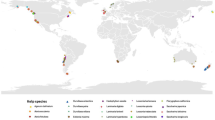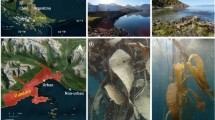Abstract
In the Shiretoko Peninsula, a World Natural Heritage site, the sustainable management of kelp forests has drawn public attention because of the economic and ecological importance of kelp. We spatially estimated the distributions of kelp forests in the Shiretoko Peninsula before and after harvest. Field surveys were conducted in coastal waters (23.74 km2) at the ends of July and August 2008, immediately before and after harvest. Data on the presence or absence and thickness of the kelp forests were collected via acoustic observation. The data were interpolated using geostatistical methods. Before harvest, the kelp forests were continuously distributed over 5.64 km2 (thickness 33–132 cm), especially near the north part of the study area. After harvest, they were sparsely distributed over 2.73 km2 (thickness 35–105 cm). In the southern part of the study area, the influence of harvests was observed as declines in forest area. In addition, relatively thickly forested areas formed the majority of the part most likely to be harvested. Selective harvesting for area and size was confirmed though quantitative mapping of kelp forests. The quantitative mapping of both the distribution and harvest of kelp forests was successful.








Similar content being viewed by others
References
Sasaki S (1973) Studies on the life history of Laminaria angustata var. longissima (M.) Miyabe (in Japanese). In: Hokkaido Fisheries Experimental Station (ed) Scientific reports of Hokkaido Fisheries Experimental Station. Hokkaido Fisheries Experimental Station, Hokkaido, pp 135–141
Makino M, Matsuda H, Sakurai Y (2009) Expanding fisheries comanagement to ecosystem-based management: a case in the Shiretoko World Natural Heritage area, Japan. Mar Policy 33:207–214
Mann KM (1973) Seaweeds: their productivity and strategy for growth. Science 182:975–981
Mukai H, Aioi K, Ishida Y (1980) Distribution and biomass of eelgrass (Zostera marina L.) and other seagrasses in Odawa Bay, central Japan. Aquat Bot 8:337–342
Komatsu T, Igarashi C, Tatsukawa K, Nakaoka M, Hiraishi T, Taira A (2002) Mapping of seagrass and seaweed beds using hydro-acoustic methods. Fish Sci 68:580–583
Holmes KW, Vanniel KP, Kendrick GA, Radford B (2007) Probabilistic large-area mapping of seagrass species distributions. Mar Freshw Ecosyst 17:385–407
Minami K, Yasuma H, Tojo N, Fukui S, Ito Y, Nobetsu T, Miyashita K (2010) Estimation of kelp forest, Laminaria spp., distributions in coastal waters of the Shiretoko Peninsula, Hokkaido, Japan, using echosounder and geostatistical analysis. Fish Sci 76:729–736
Urick RJ (1983) The nature of sonar. In: Diance H et al (eds) Principles of underwater sound. Peninsula Publishing, Los Altos, pp 1–16
Burrough PA, Mcdonnell RA (1998) Optimal interpolation using geostatistics. In: Burrough PA et al (eds) Principles of geographical information systems. Oxford University Press, New York, pp 132–161
Wackernagel H (1995) Multivariate geostatistics. Springer, New York
Penn MG, Moncrieff CB, Bridgewater SGM, Garwood NC, Bateman RM, Chan L, Cho P (2009) Using GIS techniques to model the distribution of the economically important xate′ palm Chamaedorea ernesti-augusti within the Greater Maya Mountains, Belize. Syst Biodiv 7:63–72
Kawabata S (1989) An illustrated guide to Japanese kelp. Kita Nihon Kaiyo Center, Hokkaido (in Japanese)
Hasegawa Y (1959) On the distribution of the useful laminariaceous plants in Hokkaido. Hokusuishige 16:201–206 (in Japanese)
Kikuchi S, Uki N (1981) Productivity of benthic grazers, abalone and sea urchin in Laminaria beds. In: Japanese Society of Fisheries Science (ed) Seaweed beds. Koseisha Koseikaku, Tokyo, pp 9–23 (in Japanese)
Machiguchi Y (2008) Urchin barrens. In: Fujita D et al (eds) Recovery from urchin barrens. Seizando Shoten, Tokyo, pp 22–28 (in Japanese)
Yoshida T (1998) Marine algae of Japan. Uchida Rokakuho, Tokyo (in Japanese)
Nabata S (2003) Laminaria spp. In: Notoya M (ed) Seaweed beds and creation technology. Seizando Shoten, Tokyo, pp 90–100 (in Japanese)
Ona E, Mitson RB (1996) Acoustic sampling and signal processing near the seabed: the deadzone revisited. ICES J Mar Sci 53:677–690
Minami K, Yasuma H, Tojo N, Ito Y, Fukui S, Nobetsu T, Miyashita K (2011) Estimation of kelp forest thickness using acoustic method. Math Phys Fish Sci 9:62–74 (in Japanese)
Johnston K, Jay MH, Krivoruchko K, Lucas N (2001) Using ArcGIS geostatistical analyst. ESRI, New York
Manase S, Takeda J (2001) Kriging. In: Shibata S et al (eds) Spatial data modeling. Kyouritsu Shuppan, Tokyo, pp 135–166 (in Japanese)
Yamamoto S (2000) Forest gap dynamics and tree regeneration. J For Res 5:223–229
Manabe T, Shimatani K, Kawarasaki S, Aikawa S, Yamamoto S (2009) The patch mosaic of an old-growth warm-temperate forest: patch-level descriptions of 40-year gap-forming processes and community structures. Ecol Res 24:575–586
Sabol BR, Melton E, Chamberlain R, Doering P, Haunert K (2002) Evaluation of a digital echo sounder system for detection of submersed aquatic vegetation. Estuaries 25:133–141
Komatsu T, Mikami A, Sultana S, Ishida K, Hiraishi T, Tatsukawa K (2003) Hydro-acoustic methods as a practical tool for cartography of seagrass beds. Otsuchi Mar Sci 28:72–79
Komatsu T, Tatsukawa K (1998) Mapping of Zostera marina L. beds in Ajino bay, Seto island sea, Japan, by using echosounder and global positioning system. J Rech Oceanogr 23:39–46
Nakagawa K (1953) Konbu. The Hokkaido Shimbun Press, Hokkaido (in Japanese)
Cornett ZJ (1994) GIS as a catalyst for effective public involvement in ecosystem management decision-making. In: Sample VA (ed) Remote sensing and GIS in ecosystem management. Island Press, Washington DC, pp 227–245
Sample VA (1994) Realizing the potential of remote sensing and GIS in ecosystem management planning, analysis, and policymaking. In: Sample VA (ed) remote sensing and GIS in ecosystem management. Island Press, Washington DC, pp 346–352
Acknowledgments
We thank Dr. M. Nakaoka of the Hokkaido University and Dr. T. Komatsu of the University of Tokyo for their useful comments and suggestions in this study. We are grateful to researcher Y. Fukuda and boatman K. Sudou for their kind advice and assistance. We also thank the Fisheries Cooperation Association of Rausu and the Sonic Corporation for their support in conducting this study. This study was supported by the Ministry of the Environment, Japan.
Author information
Authors and Affiliations
Corresponding author
Rights and permissions
About this article
Cite this article
Minami, K., Tojo, N., Yasuma, H. et al. Quantitative mapping of kelp forests (Laminaria spp.) before and after harvest in coastal waters of the Shiretoko Peninsula, Hokkaido, Japan. Fish Sci 80, 405–413 (2014). https://doi.org/10.1007/s12562-014-0731-0
Received:
Accepted:
Published:
Issue Date:
DOI: https://doi.org/10.1007/s12562-014-0731-0




